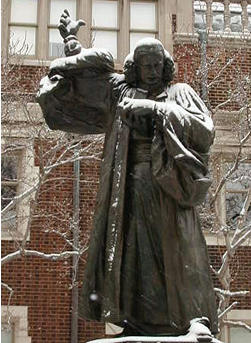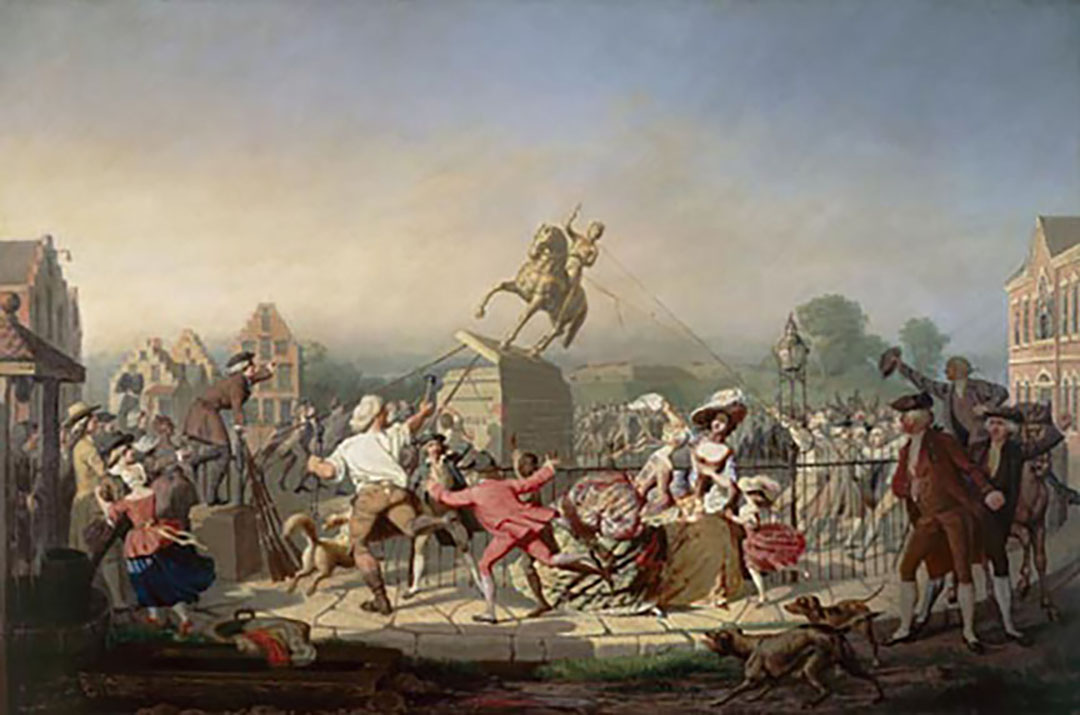George Whitefield
« previous post | next post »
 More than a decade ago, I posted about the oratorial skills of George Whitefield: "If I could only say 'O!' like Mr. Whitefield", 5/15/2009. He was an itinerant preacher who played an indirect role in the origins of the University of Pennsylvania, whose original 1740 home was a building constructed in an unsuccessful attempt to lure Whitefield to settle in Philadelphia. What I didn't know at the time was that Whitefield later played a central role in the introduction of slavery to Georgia, where he did settle:
More than a decade ago, I posted about the oratorial skills of George Whitefield: "If I could only say 'O!' like Mr. Whitefield", 5/15/2009. He was an itinerant preacher who played an indirect role in the origins of the University of Pennsylvania, whose original 1740 home was a building constructed in an unsuccessful attempt to lure Whitefield to settle in Philadelphia. What I didn't know at the time was that Whitefield later played a central role in the introduction of slavery to Georgia, where he did settle:
Slavery had been outlawed in the young Georgia colony in 1735. In 1747, Whitefield attributed the financial woes of his Bethesda Orphanage to Georgia's prohibition of slavery.He argued that "the constitution of that colony [Georgia] is very bad, and it is impossible for the inhabitants to subsist without the use of slaves.
Between 1748 and 1750, Whitefield campaigned for slavery's legalisation. He said that the colony would not be prosperous unless farmers had slave labor. Whitefield wanted slavery legalized not only for the prosperity of the colony, but also for the financial viability of the Bethesda Orphanage. "Had Negroes been allowed", he said, "I should now have had a sufficiency to support a great many orphans without expending above half the sum that has been laid out." Whitefield's push for the legalization of slavery "cannot be explained solely on the basics of economics." It was also that "the specter of massive slave revolts pursued him."
Slavery was legalized in 1751. Whitefield saw the "legalization of slavery as part personal victory and part divine will." Whitefield now argued a scriptural justification for slavery. He increased his number of slaves, using his preaching to raise money to purchase them. Whitefield became "perhaps the most energetic, and conspicuous, evangelical defender and practitioner of slavery."
Why didn't I know about that? The contents of my post came from material I'd assembled earlier, as part of an explanation of the statue for residents in the Quadrangle, where the statue sits. The first version of the Wikipedia section on Whitefield's advocacy of slavery in Georgia seems to have been added a few days before my post, and unfortunately I didn't re-read the article, or come across any other sources that explained those facts. In any case, I'm happy to report that the university has decided to remove the statue. From Amy Gutmann's message of July 2:
We are today announcing that a statue of George Whitefield that was erected in the Quad in the early twentieth-century will be removed from our campus. We make this change after careful consideration of what it means for our campus community, both now and into the future. The case for removing Whitefield is overwhelmingly strong. He was a well-known evangelical preacher in the mid-eighteenth century, who notably led a successful campaign to allow slavery in Georgia. This is undeniably one of Whitefield’s principal legacies. Honoring him with a statue on our campus is inconsistent with our University’s core values, which guide us in becoming an ever more welcoming community that celebrates inclusion and diversity.
Whitefield’s connection to Penn stems from a church meeting house he owned at 4th and Arch streets in Philadelphia which was purchased by Ben Franklin to house the Academy of Philadelphia, a predecessor to the University of Pennsylvania. Given that Whitefield prominently advocated for slavery, there is absolutely no justification for having a statue honoring him at Penn.
Should we see this kind of iconoclasm as "destroying history"? There's a meme for that:
1776: After a reading of the Declaration of Independence, New Yorkers descended on Bowling Green and pulled down a statue of King George III.
Imagine those thugs destroying history. Now we’ll never know who won the Revolutionary War.#July4th #independenceday2020 pic.twitter.com/LrOtFt0wHe
— _ #Bluenami2020 (@Tipsy_in_Texas) July 4, 2020
Here's a more elegant version of the same scene, as re-imagined in 1857 by William Walcutt:
See also Krystal D’Costa, “The History Behind the King George III Statue Meme,” Scientific American blog post, 8/23/2017.
I'm tempted to use Walcutt's painting as a Zoom background:
But I think I'll wait for a picture of Whitefield's statue coming down, which I hope will be the occasion of an analogous celebration.
Update 8/5/2020 — here's a bit of the removal process:

Dick Margulis said,
July 5, 2020 @ 7:05 am
If Penn sanctions the pulling down of the statue with ropes in the middle of a crowd of properly socially distanced, masked students, that could be a great picture. However, I'm pretty sure the university's insurance carrier would frown on that technique. I'm envisioning a temporary chainlink fence surrounding a rigger, several burly workers in hardhats, and various other accoutrements of modern, OSHA-regulated construction practice. Go with the Walcutt painting :D
[(myl) I'm sure you're right. But I'm going to argue for some sort of accompanying public ceremony, with an audience. Hard to make that competitive with Walcutt, I agree — but still…]
Mark P said,
July 5, 2020 @ 7:53 am
Thanks for this. Now I’m imagining what might have been. I suspect Georgia would have ended up a slave state at some time, but still. I should come up to see it taken down.
Rose Eneri said,
July 5, 2020 @ 8:29 am
Please help me understand the following quote from the Stephen J. Stein article referenced on Wikipedia:
"Whitefield's push for the legalization of slavery 'cannot be explained solely on the basics of economics.' It was also that 'the specter of massive slave revolts pursued him'."
Would not the "specter of massive slave revolts" argue against holding slaves?
(Although I do love the visual of the specter "pursuing" him.)
Jerry Friedman said,
July 5, 2020 @ 8:50 am
Rose Eneri: Without reading the article, I'm guessing that Whitefield thought the example of free black people in Georgia could encourage slaves in other colonies to revolt.
Rose Eneri said,
July 5, 2020 @ 8:57 am
Jerry, thank you.
Kate Bunting said,
July 5, 2020 @ 10:43 am
As the granddaughter of a Methodist lay preacher ( though I'm Anglican), I was completely unaware of this aspect of Whitefield's life. I'm relieved to see that John Wesley himself was strongly anti-slavery!
Colin McLarty said,
July 5, 2020 @ 4:20 pm
Rose Eneri: The "ban" on slavery in Georgia did not eliminate it, there were slaves there the whole time, while the "ban" was meant "to minimize the slave presence in Georgia." Legalizing slavery discouraged rebellion by those slaves. See https://en.wikipedia.org/wiki/Georgia_Experiment
Viseguy said,
July 5, 2020 @ 6:00 pm
Can I simply "like" this post? Yes…?
.
.
.
Like!
Rodger C said,
July 6, 2020 @ 10:28 am
The statue reminds me of a well-known painting of Whitefield preaching to a crowd. A creative protester should pose with it as the joker off to the right in work clothes offering him a tankard of beer.
Jim Rogers said,
July 6, 2020 @ 12:42 pm
@myl Apologies for an off-topic query that I should take time to answer myself (not to mention apologies for making any comment at all, which Geoff Pullum will never forgive me for).
Amy Gutmann's message locates the meeting house built for Whitefield as 4th and Arch which is, as I'm sure you are aware, the location of what is very nearly a "mother church" of Quakerism (Religious Society of Friends) in the US.
Does anyone know, off-hand, whether there is a connection between the two?
If there is, it is very satisfying that it has been occupied by a community that carried a message (after some time working to consensus) that was diametrically opposed to Whitefield's.
Truth abides, but takes its time in showing itself.
[(myl) The history of buildings in that location is here: https://archives.upenn.edu/exhibits/penn-history/campuses/first-campus ]
Andrew Usher said,
July 6, 2020 @ 10:21 pm
As regards Mr. Whitefield, isn't is something that the category of 'great orator' seems to have disappeared entirely? Even for people in the past century or so it would be hard to find it or a synonym applied without political bias, while no political affiliation was needed to recognise his skill, evidently.
k_over_hbarc at yahoo.com
[(myl) But the thing about Whitefield's oratory is that it was 100% delivery and 0% content, at least according to Franklin's account. There are zero famous lines attributed to Whitefield, as far as I know — Wikiquote cites three quotations, but I've never encountered any of them before. Compare MLK, who was (and is) known for content as well as for delivery; or Churchill, mainly known for content, though people still do listen to recordings.]
Nick said,
July 7, 2020 @ 6:43 am
Speaking of slavery, language and iconoclasm, we over in the electrical engineering world have the problem of systems for clocking that use the terms master and slave. These terms are written in many standards and used widely. We're looking for alternatives but there is not yet momentum for one set. Leader/follower is a common suggestion. Do you happen to have come across this discussion or have any ideas?
[(myl) There's a Wikipedia article on "Master/slave (technology)" that covers the history of terminological concerns back to 2003, and lists alternatives in use, of which "Primary/Secondary" seems to be the most used. I've seen a similar discussion somewhere about hydraulic (master cylinder and slave cylinder) but I can't now locate it.]
Robert said,
July 7, 2020 @ 8:51 am
https://www.researchgate.net/publication/236752849_Broken_Metaphor_The_Master-Slave_Analogy_in_Technical_Literature
Philip Taylor said,
July 7, 2020 @ 9:00 am
The fact that slavery is (almost) universally abhorred these days does not, of course, mean that slavery did not (and in some cases, does) exist. The word "slave" is, in itself, not offensive, and remains in common usage in phrases such as "slave to the clock". That being the case, is there any real benefit in trying to eliminate from technical vocabulary words and phrases that are universally understood, even if they were coined at a time when the prevailing mores were rather more accepting of practices that most of us today would find abhorrent ?
Rodger C said,
July 7, 2020 @ 9:19 am
Philip, imagine yourself a black American setting out to learn electrical engineering.
Philip Taylor said,
July 7, 2020 @ 12:56 pm
Robert, your "Research gate" link makes interesting reading, but I can find earlier references to "Master clock" than the author. The earliest I have found so far is 1884/5 — International Electrical Exhibition–1884, of the Franklin Institute …: General Report of the Chairman of the Committee on Exhibitions. Franklin Institute, 1885 – Electric industries – 54 pages. There are no corresponding instances of "slave", as far as I can tell.
Mark Meckes said,
July 7, 2020 @ 1:58 pm
There is recent movement on pulling down the master/slave terminology in technology: https://www.wbur.org/hereandnow/2020/07/07/master-slave-coding-terms
Sven said,
July 8, 2020 @ 9:45 am
In german, in the context of real clocks, e.g. at train stations, the terms "Mutteruhr" and "Tochteruhr" (mother/daughter clock) are used, but it sounds somewhat old fashioned today. I cannot imagine that these terms would be introduced for new technology now.
Jarek Weckwerth said,
July 8, 2020 @ 5:07 pm
Given that the language of IT is chock full of metaphor, I envisage hard times ahead. (Many would describe me as Slavic, so…)